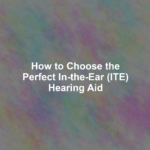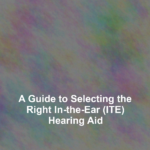Have you ever considered how the right in-the-ear hearing aid could significantly enhance your daily life? As you navigate the myriad options available in the market, itG??s essential to understand that the best ITE hearing aid for you should align with your specific hearing needs and lifestyle.
From sleek, almost invisible designs to those packed with cutting-edge technology, these devices vary widely. YouG??ll want to compare brands and models, but donG??t overlook the importance of compatibility with your daily activities and personal preferences.
Moreover, understanding the intricacies of pricing and insurance can make a substantial difference in your investment. As we explore these critical factors together, youG??ll find yourself equipped to make an informed decision that could transform your auditory experience.
But first, letG??s examine why assessing your hearing needs is a crucial starting point on this journey.
Assess Your Hearing Needs
Before selecting an ITE (In-the-Ear) hearing aid, itG??s crucial to evaluate your specific hearing requirements to ensure you choose a device that best suits your lifestyle and hearing loss level. Start by visiting a certified audiologist who can perform a comprehensive hearing assessment. TheyG??ll determine the type and degree of your hearing loss and consider any additional factors, like your ear anatomy, which can influence the fit and comfort of your ITE hearing aid.
YouG??ll need to think about your daily environments. Do you often find yourself in noisy settings, or are you usually in quieter places? Some ITE hearing aids have advanced features like noise reduction and directional microphones that are beneficial in loud environments. Also, consider your manual dexterity. ITE hearing aids are smaller and can be trickier to handle, so if you have issues with fine motor skills, a larger device might be more practical.
Lastly, reflect on your aesthetic preferences. ITE devices are less visible than other styles, which appeals to many. However, the smallest models may not have room for features like volume controls or telecoil. ItG??s essential to balance your desire for discretion with functionality. Choose wisely, as the right hearing aid can significantly improve your quality of life.
Consider Lifestyle Compatibility
When choosing an ITE hearing aid, ensure it aligns with your daily activities and social interactions to maximize its benefits. Your lifestyle plays a pivotal role in this decision. If youG??re active, youG??ll want a device thatG??s moisture-resistant and can handle the rigors of movement. For a bustling social life, look for features that enhance speech clarity in noisy environments.
Consider the types of technology you frequently use. If youG??re often on the phone or use multimedia devices, seek out hearing aids that can seamlessly connect via Bluetooth or have t-coil options. This will allow you to enjoy conversations and entertainment without unnecessary hassle.
DonG??t forget to think about your work environment. If youG??re in a job that requires keen hearing or frequent communication, youG??ll need a hearing aid thatG??s up to the task. Models with directional microphones could be particularly beneficial, as they can help you focus on the conversation at hand.
Lastly, if discretion is key for you, choose a color and style that closely matches your skin tone or is less visible in the ear. By considering how well the hearing aid fits with your lifestyle, youG??ll be more likely to wear it consistently and reap the full advantages it offers.
Explore Technology Features
As you delve into the world of ITE hearing aids, prioritize examining the spectrum of technological features to find a device that aligns with your needs. TodayG??s ITE hearing aids are packed with advanced technologies that can dramatically enhance your hearing experience. Look for features such as directional microphones, which focus on sounds coming from in front of you and reduce background noise.
YouG??ll also want to check if the hearing aid offers wireless connectivity options like Bluetooth, allowing you to stream audio directly from your smartphone, TV, or other devices. This can be a game-changer for enjoying phone calls, music, and movies with greater clarity. Additionally, consider models with tinnitus masking features if you experience ringing in your ears.
DonG??t overlook the importance of a good feedback cancellation system. This reduces the whistling sound that can occur when the hearing aid picks up its own amplified sound. And if youG??re tech-savvy, you might appreciate a hearing aid that pairs with a mobile app, giving you the flexibility to adjust settings right from your phone.
Compare Brands and Models
Dive into the specifics of different brands and models to pinpoint the ITE hearing aid that best suits your lifestyle and hearing requirements. DonG??t get overwhelmed by the variety; instead, focus on the key features that matter to you. Leading brands like Oticon, Phonak, and Starkey have their own take on ITE devices, each with unique advantages.
OticonG??s models are renowned for their BrainHearing technology, which supports the way your brain naturally processes sound. Phonak offers a broad range of ITE aids, including the Virto series, known for customization and clear sound quality. Starkey, on the other hand, is acclaimed for its American-made products with advanced features like tinnitus relief and health tracking.
YouG??ll want to compare these options side-by-side. Look at battery life, wireless connectivity, and feedback cancellation. Check user reviews to gauge reliability and customer satisfaction. Remember, a higher price doesnG??t always equate to better quality. Sometimes, mid-range models offer the best balance between cost and functionality.
Visit a hearing care professional who can demo different models for you. TheyG??ll also help you understand which features align with your hearing loss pattern. Trust your instincts and choose a model that feels comfortable and enhances your daily life without breaking the bank.
Understand Pricing and Insurance
After selecting the ideal ITE hearing aid model, youG??ll need to consider the financial aspect, including the cost and insurance coverage options available to you. ITE hearing aids can vary widely in price, typically ranging from a few hundred to several thousand dollars. This cost often reflects the technology level, features, and customization of the device.
ItG??s crucial to check with your insurance provider to see what part of the cost, if any, is covered by your plan. Unfortunately, not all insurance plans cover hearing aids, and Medicare generally doesnG??t include them in its benefits. However, some private insurers or Medicare Advantage plans might offer partial coverage or discounts through affiliated providers.
DonG??t forget to inquire about financing options or payment plans, which can make the purchase more manageable. Additionally, some hearing aid providers offer trial periods or money-back guarantees, which can give you some financial flexibility.
Conclusion
YouG??ve taken the time to assess your hearing needs, weigh your lifestyle, and explore the tech features of various in-the-ear hearing aids.
Now, with comparisons of brands and models in mind, and an understanding of pricing and insurance factors, youG??re equipped to make an informed decision.
Choose the hearing aid that feels right for you, and look forward to the clarity and connection itG??ll bring to your daily life.
Trust your instincts and enjoy the sounds around you.











